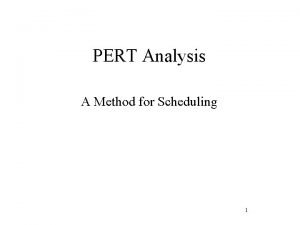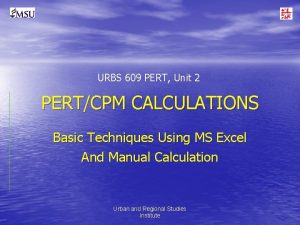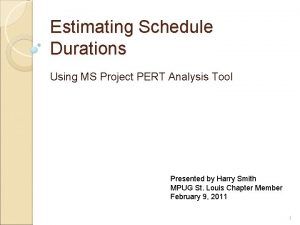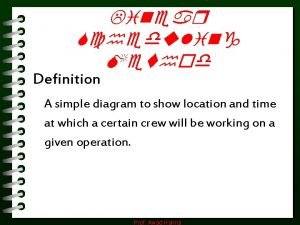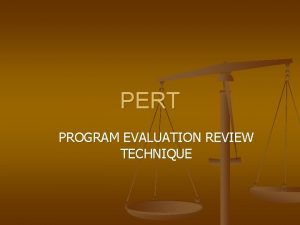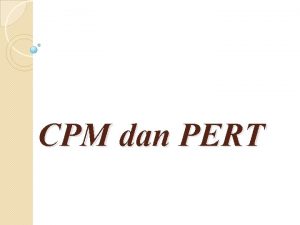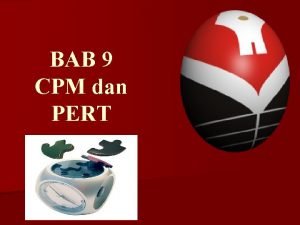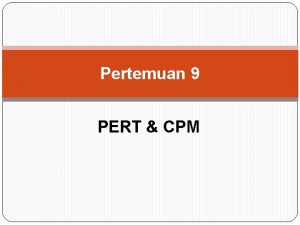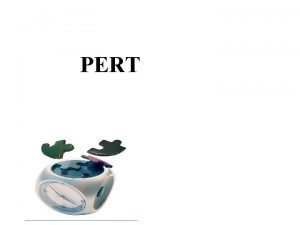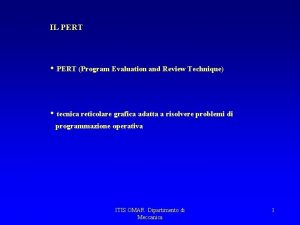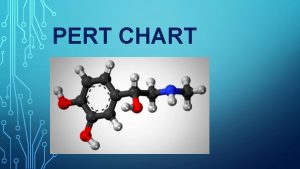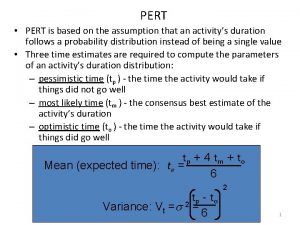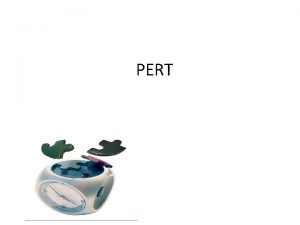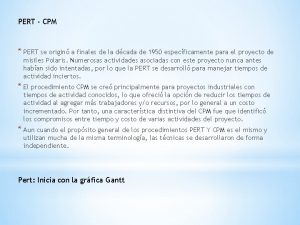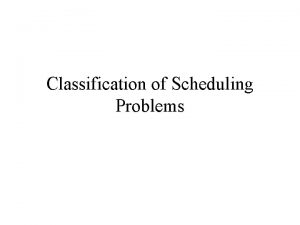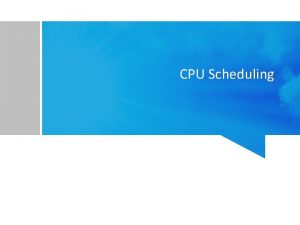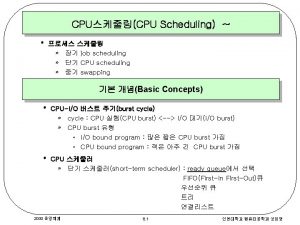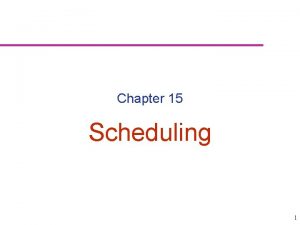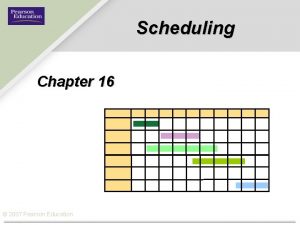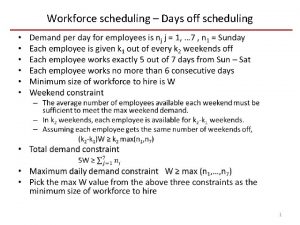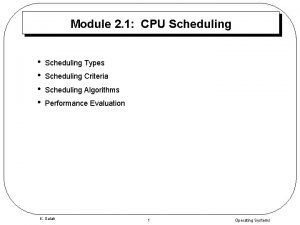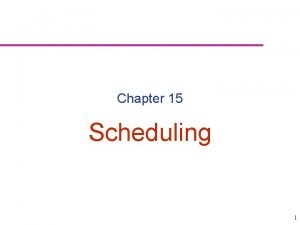PERT Analysis A Method for Scheduling 1 Introduction






















- Slides: 22

PERT Analysis A Method for Scheduling 1

Introduction • Managers have been planning, scheduling, monitoring, and controlling large scale projects for hundred years, but it has only been in the last 50 years that management science techniques have been applied to major projects. • In 1957, the Critical Path Method (CPM) was developed by Kelly and Walker to assist in building and maintenance of chemical plants. • In 1958, the special projects office of the US navy developed the Program Evaluation and Review Technique (PERT) to plan and control the Polaris missile program. • In the recent time, PERT and CPM are two popular management science techniques that help mangers plan, schedule, monitor, and control large scale and complex projects 2

Introduction • PERT stands for Program Evaluation and Review Technique. • CPM stands for Critical Path Method. • PERT/CPM is used to plan the scheduling of individual activities that make up a project. • PERT/CPM can be used to determine the earliest/latest start and finish times for each activity, the entire project completion time and the slack time for each activity. • PERT and CPM are similar in their basic approach, they do differ in the way activity times are estimated. • For each PERT activity three times (optimistic, pessimistic and most likely times) are combined to determine the expected activity completion time and its variance. Thus, PERT is a probabilistic technique: it allows us to find the probability of the entire project being completed by any given date. • CPM, on the other hand, is called a deterministic approach. It uses two time estimate, the normal time and the crash time, for each activity 3

Importance of PERT/CPM • By using PERT and CPM analysis you will be able to answer questions such as: 1. When will the entire project be completed? 2. What are the critical activities or tasks in the project, that is, the ones that will delay the entire project if they are late? 3. Which are the noncritical activities, that is, the ones that can run late without delaying the whole project’s completion time? 4. What is the probability that the project will be completed by a specific date? 5. At any particular date, is the project on schedule, behind schedule, or a head of the schedule? 6. On any given date, is the money spent equal to, less than, or greater than the budgeted amount? 7. Are there enough resources available to finish the project on time? 8. If the project is to be finished in a shorter amount of time, what is the best way to accomplish this at the least cost? (crash analysis) 4

CPM (Critical Path Method) • Finding the critical path is a major part of controlling a project. • The activities on the critical path represent tasks that will delay the entire project if they are delayed. • Manager gain flexibility by identifying noncritical activities and replanning, rescheduling, and reallocating resources such as personnel and finances 5

Critical Path Methodology • Given deterministic activity times, it is possible to; • Describe a project as a network • Find a critical path through the network. 6

Descript Foundation Frame Order Windows Walls Wiring Plumbing Ducting Dry Wall Install Windows Paint & Clean Idx A B C D E F G H I J Predece NA A NA B D D D EFG BC H Duration 4 4 11 3 4 3 1 2 7

Project (NB Parallel) B(4) 1 A(4) 3 D(3) 2 5 E(4) G(4) B(4) C(11) I(1) 6 H(3) J(2) 8 F(3) 7 4 8

To Carry out CPM • Set up network with dummy nodes so that activities do not finish at same place. • Do a ‘forward’ pass and a ‘backward’ pass. • Based on this, identify the ‘critical path. ’ • See if you can do this now. 9

Solution in Excel • It is possible to set up the activities in Excel, and explicitly code dependencies. • If you are careful with the choice of constraints, you can ‘solve’ the network using Solver. • In any case it is possible to readily summarise the features of the project. 10

‘Realistic’ Scenario • However, it should be clear that activities do not, in practice, take fixed time known a priori. • CPM is appropriate for the deterministic situation. • Another methodology, developed at the same time, is PERT. 11

PERT • PERT stands for Programme Evaluation and Review Technique. • It has its origins in the Polaris missle project. • A key output is time to completion of project. • Times can be uncertain. 12

PERT Distn • The PERT distn is used to summarise times for parts of projects. • It is a distn taking min a, most likely b and max c. (Based on input of 3 estimated durations per task) – Most Optimistic (a) – best case scenario – Most Likely (b) “normal” scenario – Most Pessimistic (c) Worst case scenario • It is ‘smoother’ than triangle. • It is in fact a Beta distribution “stretched” to fit the interval (a, c) with max at b. 13

Parameterisation 14

15

16

17

Descript Foundation Frame Order Windows Walls Wiring Plumbing Ducting Dry Wall Install Win Paint & Clean Idx A B C D E F G H I J Pred NA A NA B D D D EFG BC H Param 1. 5, 3. 5, 8. 5 3, 4, 5 7, 10, 19 2, 2. 5, 6 3, 3. 5, 7 2, 2. 5, 6 2, 4, 6 2. 5, 3, 3. 5 0. 5, 1, 1. 5, 2, 2. 5 18 Mu 4 4 11 3 4 3 1 2

In Excel • Thus, we have a table with all activities. • Each time is considered an independent random variable. • The total project time is also a random variable. • It can be simulated, or approximated analytically. 19

Questions of Interest • What is the expected project time? • What is the probability the time of the project is less than 22 days (say)? • What are the critical activities? • Can an activity be ‘probabilistically’ critical? 20

Simulation Approach • • Treat activities as conditionally independent. Simulate a time for each. Examine the combination of activity times. Examine the effect of each on the total time if this is of interest (by, for example, adding ‘delta’ to each activity in turn. ) 21

Summary • PERT is another method of examining project scheduling. • It involves the stochastic specification of activity times. • The PERT distribution is a Beta. • Simulation allows the answering of questions that arise in a realistic fashion. 22
 Job scheduling vs process scheduling
Job scheduling vs process scheduling Pert analysis
Pert analysis Pert unit
Pert unit Ms project pert
Ms project pert Linear scheduling method
Linear scheduling method Conclusion of symposium
Conclusion of symposium Kontinuitetshantering
Kontinuitetshantering Typiska novell drag
Typiska novell drag Tack för att ni lyssnade bild
Tack för att ni lyssnade bild Returpilarna
Returpilarna Varför kallas perioden 1918-1939 för mellankrigstiden
Varför kallas perioden 1918-1939 för mellankrigstiden En lathund för arbete med kontinuitetshantering
En lathund för arbete med kontinuitetshantering Adressändring ideell förening
Adressändring ideell förening Vilotidsbok
Vilotidsbok Anatomi organ reproduksi
Anatomi organ reproduksi Förklara densitet för barn
Förklara densitet för barn Datorkunskap för nybörjare
Datorkunskap för nybörjare Stig kerman
Stig kerman Hur skriver man en debattartikel
Hur skriver man en debattartikel För och nackdelar med firo
För och nackdelar med firo Nyckelkompetenser för livslångt lärande
Nyckelkompetenser för livslångt lärande Påbyggnader för flakfordon
Påbyggnader för flakfordon Tryck formel
Tryck formel

